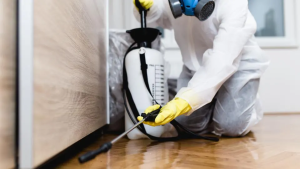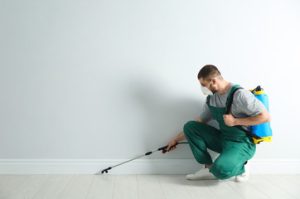Pests are undesirable organisms (insects, diseases, weeds, nematodes, viruses) that damage or spoil crops, food stores, lawns, gardens, buildings, and household possessions. They also displace native plant species and alter environmental factors such as soil health, nutrient content, water availability, and fire events. For more information, click the Learn More Here.
Physical or mechanical controls are traps, screens, barriers, netting, and other devices that physically prevent pest access to plants and structures. These methods are often used in combination with biological or chemical controls.

There are several steps that can be taken to prevent pest infestation. These steps include sealing entry points, maintaining cleanliness, controlling moisture, and reducing clutter. Preventing pests also involves being observant and listening for signs of pests, such as scratching noises in walls or attics and crawl spaces, gnawing marks or droppings, and a musty or smoky odor.
Crawling or walking pests, such as rats, mice, ants, beetles, centipedes, and millipedes, are another type of pest that can cause serious problems in homes and businesses. These pests are often attracted to food, water, and shelter. Preventing these pests involves keeping kitchen areas clean, storing food in airtight containers, and disposing of garbage in tightly sealed bins. It is also important to check and seal any cracks or holes in foundations, walls, and around windows and doors.
It is also important to note that certain pests increase or decrease in numbers depending on the season. For example, rodents such as mice and rats might increase in population during the winter because they are looking for warmth and shelter. Similarly, mosquitoes might become more active in summer because they are looking for blood. Recognizing the seasonal variations in pest populations can help in predicting when to take control measures.
There are a variety of control measures that can be used to prevent pests, including physical barriers, cultural practices, and pesticides. One approach to prevention is called integrated pest management (IPM). IPM strategies involve monitoring pest activity to identify problem areas and determine the best course of action. This approach reduces reliance on pesticides by using biological controls and habitat manipulation to prevent pests instead of just killing them with chemicals. In addition, pesticides are only applied when necessary and are chosen and applied in a way that minimizes risks to humans, beneficial organisms, nontarget plants, and the environment. IPM is usually the preferred method of pest control because it is more environmentally friendly than other options. However, pests may still need to be killed when prevention methods are not successful. Suppression and eradication are two other common control strategies.
Suppression
Pest control involves reducing a pest population to an acceptable level. This may be accomplished through prevention, suppression, or eradication. Prevention is the most desirable method of pest control, as it prevents pests from becoming a problem in the first place. However, in outdoor environments, it is often impossible to eliminate all pests. In addition, some pests are necessary in natural food chains and ecosystems. In such situations, the goal of pest control is usually to minimize harm caused by a particular species of pest.
A good first step is to learn more about a particular pest. This will help you understand what attracts it, what its needs are, and whether it causes harm to humans, animals, or property. This knowledge can help you decide if action is needed and what kind of actions are most appropriate.
For example, if you have a cockroach infestation, you might try to take steps to make your home less welcoming by taking away its food sources and shelter. This might involve removing garbage regularly and keeping storage areas clean. It might also include repairing cracks, crevices and holes where pests could enter your house. You might use caulk, plaster or concrete to seal these openings, and you should put drain screens over sinks and tubs.
Other steps might involve avoiding food sources that are attractive to pests, such as compost piles and overripe fruit. Preventive steps might also include repairing any leaky pipes or faucets in your home, and storing wood outside rather than in storage rooms where bugs and other pests can hide.
In gardening, a preventive approach to pest control is to use garden sprays and baits that are targeted to the specific pests harming your plants. In addition, certain plant oils, such as garlic, thyme, and rosemary, have insecticidal properties.
Chemical treatment might be necessary for severe infestations or to address pests that are resistant to other methods of control. If this is the case, be sure to choose a product with a low toxicity that is labeled for use in homes. It is also important to follow the application instructions carefully and read all labels.
Eradication
A pest is any organism that negatively impacts human activities and environment. Human response to such impacts can range from tolerance, through deterrence and suppression, to eradication. Eradication is usually a last resort in outdoor situations, but is sometimes attempted, especially when a foreign pest has been accidentally introduced and has not yet established itself. Mediterranean fruit fly, gypsy moth, and fire ant control programs are examples of eradication initiatives. In indoor areas, where there is greater control over the environment, eradication is more feasible, and it is often the goal of pest control efforts.
To eradicate a pest infestation, steps must be taken to eliminate the entire population of the organism. This is a highly complicated process, often requiring large-scale, coordinated efforts at the local, regional, national, or even global level. A successful eradication program must address many different dimensions of the pest problem, including its impact on humans and the environment. It must also ensure that the targeted microbe does not return to a reservoir in its natural environment or in laboratories.
Chemical eradication involves the use of chemicals to eliminate pests. This can include anything from repellents, which stop pests from entering a territory, to insecticides, which kill the insects. Chemicals used in eradication can be dangerous to humans and the environment, and they must be carefully chosen and applied. They must also be monitored to ensure they are effective, and they must be replaced if they are not.
Physical eradication includes traps, netting, and other non-chemical control methods. These are often aimed at stopping pests before they enter a property, and can involve placing traps in places where pests are known to hide. These may be placed in the soil, woodpiles, and in crawl spaces. It can also involve removing objects that attract and harbor pests, such as debris or items left near entrances.
Biological eradication uses other living organisms to reduce or remove pests. This can involve introducing a species that naturally predatory or parasitic on a pest, or it may be more dramatic, such as releasing an organism that is pathogenic to the pest in question. This is one of the oldest forms of pest control, but it can be difficult to implement in a controlled setting.
Monitoring
Pests can cause damage to property, crops and people’s health. Regular inspections and treatment can prevent pest problems before they get out of hand, preserving the value of your home or business and avoiding costly repairs or loss of products.
Preventing pest infestations from occurring is much more cost-effective and environmentally friendly than dealing with an established problem. Prevention methods include physical exclusion (screening, caulking and plastering), environmental management (watering, cleaning and storing materials in locations where pests are not attracted) and repelling (using scents or visual devices that deter pests from entering).
The most important step in monitoring is accurate identification. This is because a pest control program can be tailored to the specific needs of each pest, depending on its habits, life cycle and damage potential. It is also possible to determine the location of a harborage point by examining traps or other captures. For example, if an inspector finds a high number of first-instar German cockroaches in a trap, it is likely that there are many more harborage sites nearby.
Observing and identifying pests is done through a combination of visual inspection, trapping and scouting. Different types of traps are used, depending on the type of pest being monitored. Some traps, such as pheromone and species-specific insecticide traps, use attractants or lures to target the behavior of specific groups of pests. Passive traps, on the other hand, are designed to intercept pests as they carry out their normal activities.
Another important component of monitoring is observing the impact that pests have on an area, including the types and numbers present and the extent of their damage. This information is useful in determining the urgency of an outbreak, and it can also help establish threshold levels that indicate when a pest control treatment is required.
Museums can prevent pest problems by implementing good hygiene practices, such as storing materials in sealed containers and regularly cleaning and dusting shelves. Staff should be alert to the presence of pests, particularly if they are making scratching or scurrying noises, which may suggest that they are hiding in crevices or other inaccessible places. The noises should be reported immediately to the pest control company so that a treatment plan can be implemented as quickly as possible.


